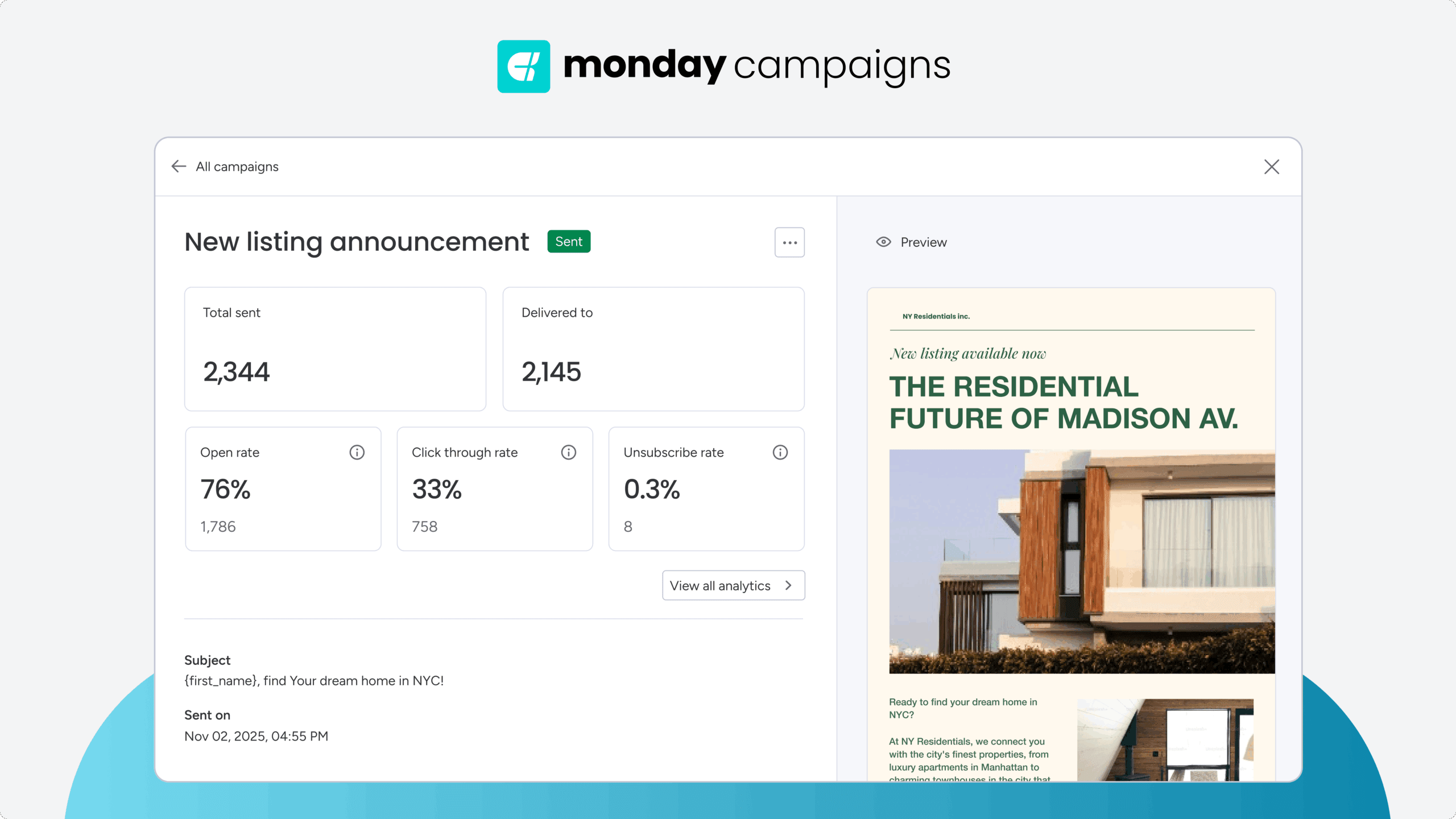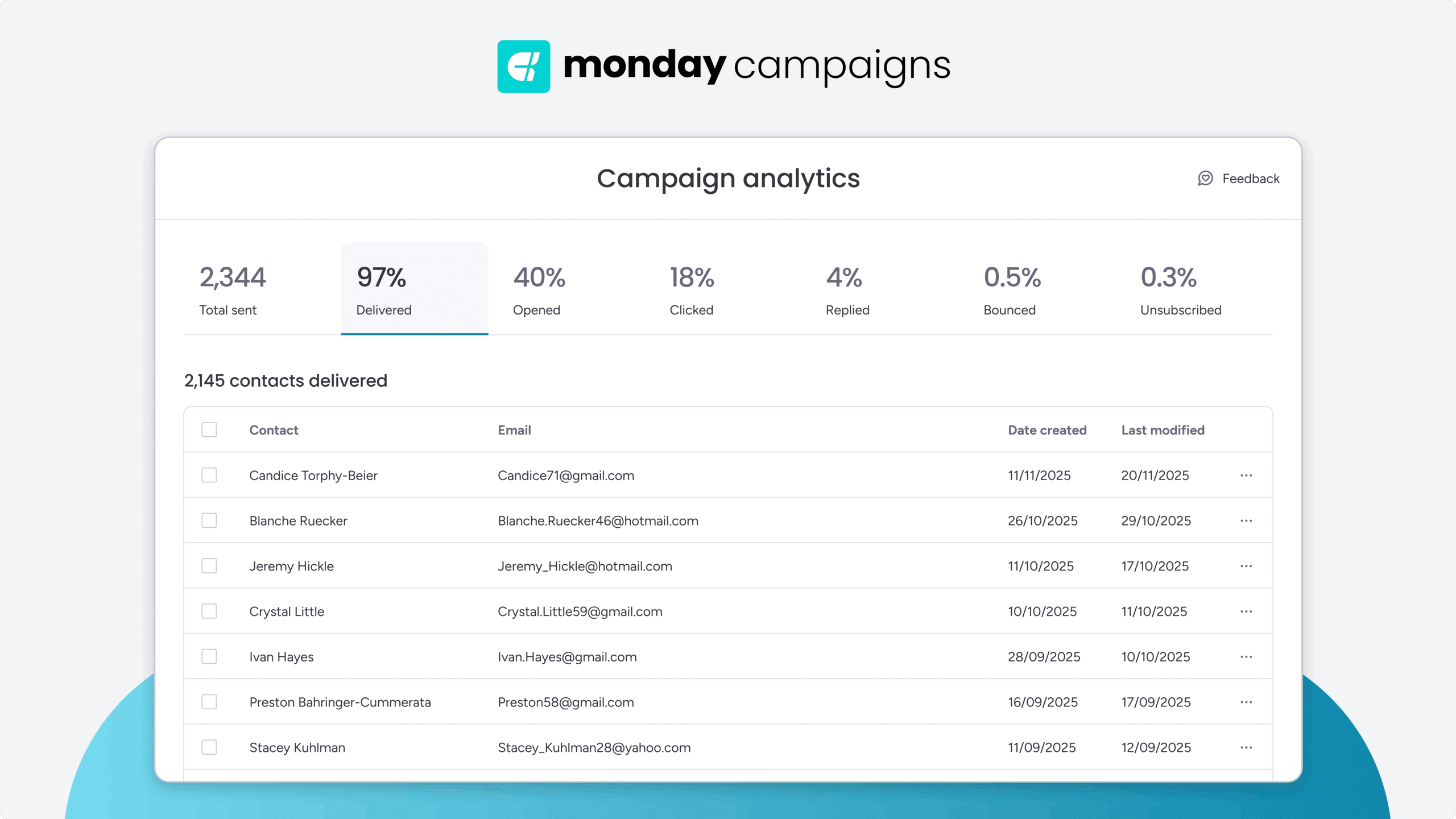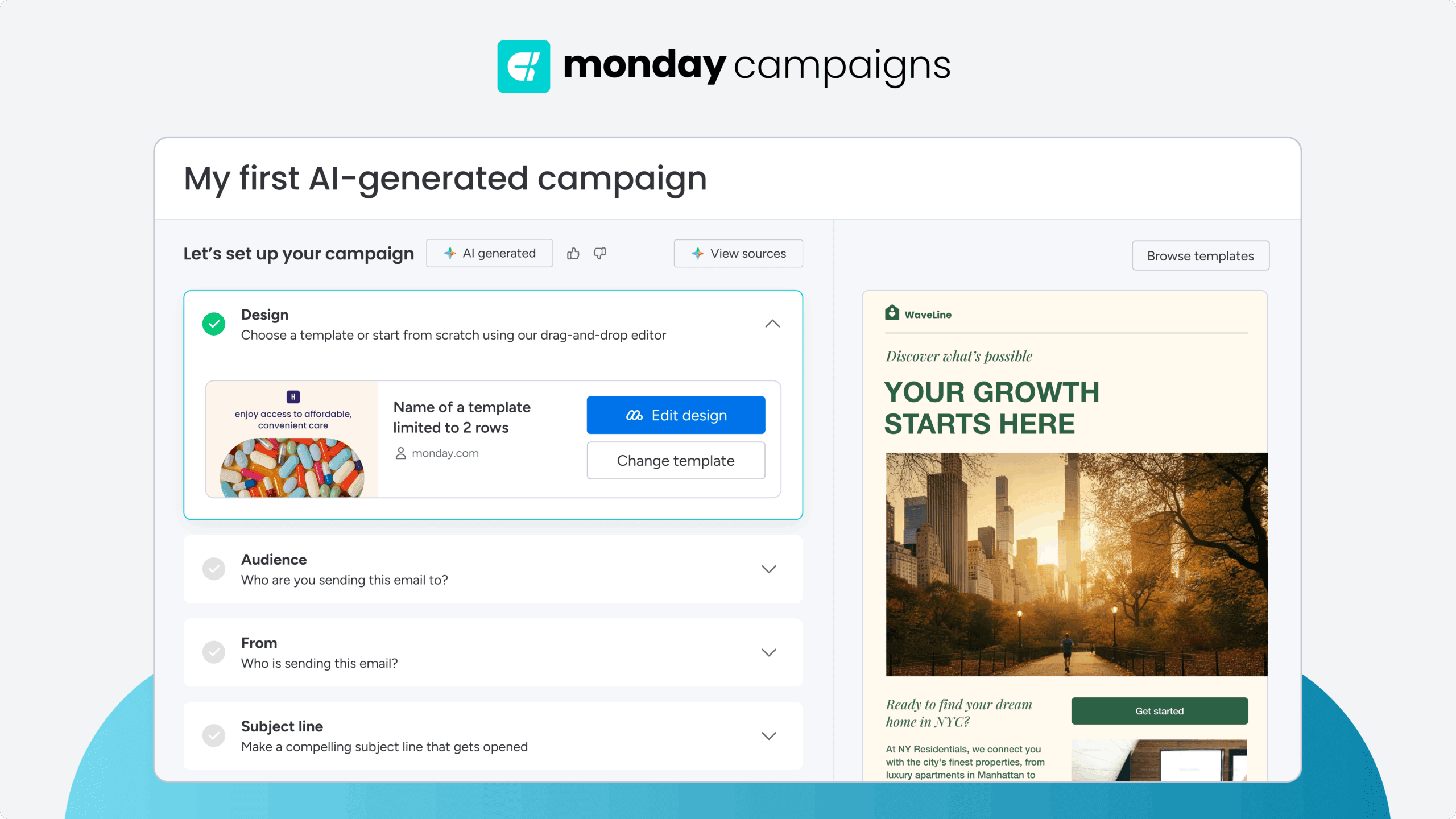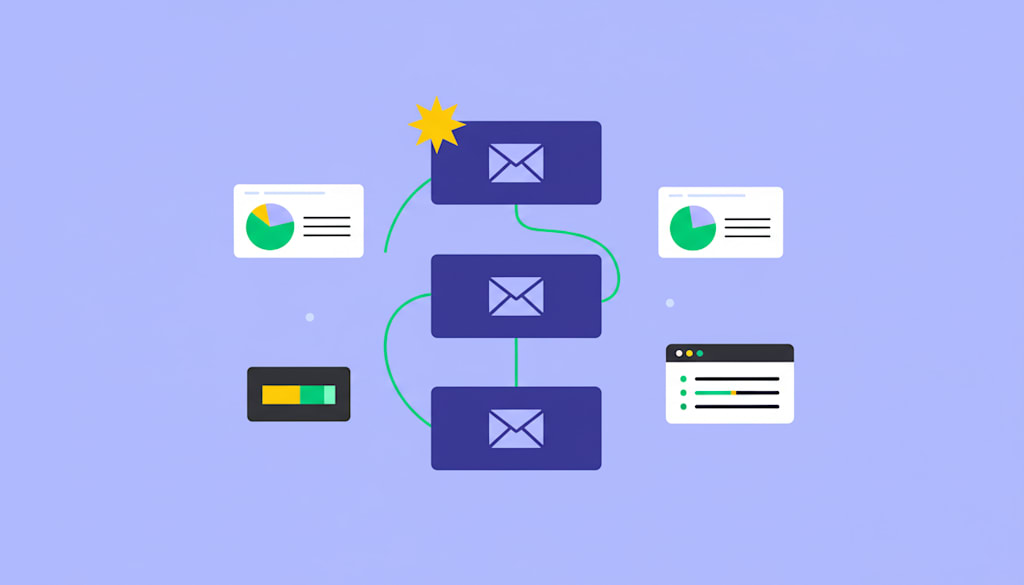More emails don’t mean more engagement. In fact, sending too often can fatigue subscribers and hurt performance. The real differentiator isn’t volume — it’s timing, frequency, and intent. Your email cadence is the rhythm that turns one-off messages into a consistent, data-driven conversation your audience actually anticipates.
In this guide, you’ll learn how to build that rhythm step by step: 15 actionable tips for optimizing when, how often, and in what order you send. You’ll also see real examples from B2B, e-commerce, and SaaS teams while discovering how AI-powered tools like monday campaigns automate cadence optimization to deliver the right message at exactly the right moment.
Try monday campaignsKey takeaways
- Email cadence combines when you send, how often, and in what order to create engagement patterns subscribers actually want.
- Different subscriber groups need different approaches, from daily nurturing for new prospects to monthly updates for loyal customers.
- Emails that respond to what subscribers actually do get significantly higher engagement than calendar-based sending.
- Track engagement patterns, unsubscribe rates, and conversion data to refine your strategy and catch problems early.
- AI-powered platforms like monday campaigns automatically optimize send times for each subscriber by learning individual engagement patterns and connecting email data directly to your CRM.
What is email cadence and why it drives engagement
Email cadence is the timing and frequency of emails you send to subscribers. This means planning when emails go out, how often people receive them, and in what order — all based on data rather than guesswork.
Think of it as the rhythm of your email communication, fueling customer engagement. With 88% of users who check their inbox multiple times a day, your emails need strategic timing to keep subscribers engaged without overwhelming them.
Email cadence fundamentals
Email cadence has 3 main parts that work together: timing, frequency, and sequence.
- Timing: The specific days and hours emails are sent
- Frequency: How often subscribers receive emails
- Sequence: The order and relationship between emails (Intro → Education → Offer)
These elements separate strategic email programs from random blasts. When you send mass email to everyone at once, you’re guessing. When you use cadence, you’re making informed decisions based on subscriber behavior.
The connection between timing and subscriber engagement
The right timing makes subscribers actually want to open your emails. When messages arrive at convenient moments, people engage more. When timing is random, emails get buried or deleted.
Consistent timing also builds anticipation. Subscribers start expecting your emails and make time for them. This connection is driven by a few key psychological factors that turn random emails into a welcome routine.
- Trust through consistency: Regular emails at predictable times become part of your subscribers’ routine.
- Visibility through timing: Strategic send times mean emails arrive when people check their inbox.
- Interest through balance: The right frequency keeps subscribers engaged without annoying them.
Benefits of getting frequency right
Strategic cadence directly impacts revenue and customer relationships. When emails align with customer needs and buying cycles, email conversion rate increases. When frequency matches preferences, subscribers stay engaged longer.
This approach also protects your sender reputation. Fewer unsubscribes and spam complaints mean your emails keep reaching inboxes. Your list stays healthy and responsive over time.
Try monday campaigns15 data-driven tips to transform your email cadence
Each of the following email cadence tips addresses a specific challenge in timing, frequency, or sequencing, with clear implementation steps you can apply immediately. Whether you’re starting from scratch or optimizing an existing program, these tactics will help you send fewer, better emails that subscribers actually want to receive.
1. Segment audiences for personalized timing
Not all subscribers engage the same way, so segment email lists by behavior, lifecycle stage, or engagement level. Each group gets its own cadence and content focus — frequent nurturing for new subscribers, steady updates for active users, and slower, value-driven re-engagement for dormant ones.
For example, new subscribers get a welcome series every 2–3 days; loyal customers get monthly updates.
2.Balance consistency with subscriber preferences
Consistency builds recognition, but respecting preferences prevents fatigue. Maintain a predictable schedule while giving subscribers options to choose how often and what type of content they receive. Test different sending frequencies — weekly vs. biweekly, for instance — to see where engagement stays strongest before locking in your cadence.
Preference centers make this easy to scale by letting subscribers fine-tune their own frequency choices, reducing unsubscribes over time.
3. Align cadence with customer lifecycle stages
Cadence should evolve as subscribers move from awareness to consideration to retention. Match timing and content to their stage in the journey:
| Stage | Email Focus | Recommended Cadence |
|---|---|---|
| Awareness | Educate and introduce value | Every 2–3 days (short series) |
| Consideration | Nurture with comparisons or social proof | Weekly |
| Retention | Reinforce loyalty and share updates | Monthly or quarterly |
4. Implement progressive profiling strategies
Progressive profiling collects subscriber information gradually. Start with just an email address. Ask for more details through subsequent interactions.
This approach reduces signup friction while building detailed profiles over time. You might ask about company size in one email, then industry challenges in another.
5. Create compelling re-engagement campaigns
Re-engagement campaigns target subscribers who haven’t opened emails recently. Send 3–4 messages over 2 weeks with different approaches. Start with a friendly check-in, offer exclusive content, then give a final chance to stay subscribed.
This process maintains list health while respecting subscriber choices. Some will re-engage, others will unsubscribe — both outcomes improve your email performance.
6. Leverage AI for send time optimization
AI analyzes when each subscriber typically opens emails and automatically adjusts send times. This goes beyond demographic averages to true email personalization.
Did you know that monday campaigns uses AI to optimize delivery for each person on your list? The system learns from engagement patterns and continuously improves timing without manual work.
7. Set up subscriber preference centers
Preference centers put subscribers in control. They choose email frequency, content types, and communication preferences. Options might include:
- Frequency choices: Daily digest, weekly summary, or monthly newsletter
- Content preferences: Product updates, industry news, or promotional offers
- Format options: HTML emails, plain text, or mobile-optimized versions
8. Monitor engagement metrics in real-time

Real-time monitoring helps you spot issues immediately. Track open rates, clicks, conversions, and unsubscribes as campaigns run. Set up alerts for unusual changes.
Quick responses to engagement drops can save campaigns. You might pause a poorly performing email or adjust frequency before losing subscribers.
9. Adjust frequency for inactive segments
Inactive subscribers need special treatment. Reduce their email frequency gradually to avoid further disengagement. Create tiers based on inactivity length:
| Inactivity period | Recommended action | Example |
|---|---|---|
| 30–60 days | Cut frequency by half | Move from weekly to biweekly |
| 60–90 days | Switch to minimal contact | Send one monthly check-in |
| 90+ days | Launch re-engagement or remove | Offer opt-in or unsubscribe cleanup |
10. Align sales and marketing cadences
When marketing and sales teams coordinate, prospects get consistent experiences. Share visibility into all touchpoints to prevent overwhelming contacts with too many messages.
Connecting email activity with CRM data, monday campaigns ensures both teams see every interaction in one place, making coordination seamless.
11. Coordinate multi-channel touchpoints
Email doesn’t work in isolation. Coordinate timing with social media posts, ads, and sales calls. Stagger messages across channels to reinforce your message without overwhelming prospects.
Map out all touchpoints in a campaign calendar. This visual approach helps identify conflicts and opportunities for reinforcement.
12. Personalize content within sequences
Dynamic content adapts to each subscriber. Product recommendations reflect browsing history. Content suggestions match previous engagement. Messages align with lifecycle stage.
This personalization makes every email feel relevant. Subscribers see content that matches their interests and needs.
13. Design segment-specific workflows
Different audiences need different approaches. B2B prospects want educational content and ROI data. B2C customers prefer product features and social proof.
Create separate workflows for major segments. Enterprise leads might get longer sequences with detailed case studies. Small businesses might receive shorter sequences focused on quick wins.
14. Automate based on lifecycle triggers
Lifecycle triggers create timely, relevant touchpoints. First purchase triggers a thank you and usage tips. Subscription renewal triggers a reminder and exclusive offer. These automated sequences run without manual intervention.
Set up triggers for key milestones in your customer journey. Each trigger should start a sequence designed for that specific moment.
15. Test and refine continuously
Email cadence needs constant optimization. Set up regular testing schedules for timing, frequency, and sequence length. Document results and apply findings to future campaigns.
What works today might change tomorrow. Subscriber preferences evolve, so your cadence strategy should too.
High-converting email cadence examples
Real-world examples show how different businesses structure their sequences. Use these frameworks as starting points and adapt them to your audience.
B2B email sequence templates
Goal: Build authority and guide leads toward conversion
B2B email sequences typically span 2–4 weeks, with emails every 2–3 days. Start with educational content, introduce your solution gradually, and close with a clear call to action. Here’s an example cadence:
- Day 1: Welcome and industry insight
- Day 3: Relevant case study
- Day 7: Educational content addressing pain points
- Day 14: Consultation offer
E-commerce and retail campaigns
Goal: Drive quick decisions through timely, high-frequency touchpoints
E-commerce campaigns move faster due to shorter buying cycles. Cart abandonment flows perform best with an immediate reminder email, 24-hour follow-up featuring reviews, and a 72-hour final offer.
Post-purchase sequences then reinforce loyalty through delivery updates, usage tips, and cross-sell suggestions.
SaaS onboarding workflows
Goal: Drive product adoption and reduce churn
SaaS onboarding focuses on helping new users find value quickly:
- Day 1: Welcome + setup guide
- Day 3: Feature tutorial or video demo
- Day 14: Success story or upgrade prompt
This sequence supports early wins and prevents drop-off before users form habits.
Lead nurturing sequences
Goal: Build long-term engagement and trust
Drip campaigns deliver consistent value over time. Share educational resources, insights, and customer stories rather than hard sells. Send weekly or biweekly to stay visible without overwhelming subscribers. Value-driven content keeps your brand top of mind between major campaigns.
Want to make email cadence creation easier? Look at our free email templates for inspiration.
Measuring and optimizing email cadence performance

Tracking the right metrics ensures continuous improvement. Focus on measurements that connect to business outcomes, not just email statistics.
Critical metrics for cadence success
Look beyond opens and clicks to measure real impact. For example:
| Metric | What it measures | Why it matters |
|---|---|---|
| Open rate | Subject line appeal + timing | First signal of engagement |
| Click-through rate (CTR) | Content relevance | Indicates conversion potential |
| Conversion rate | How many take desired action | Ties cadence to revenue |
| Unsubscribe rate | Disengagement | Identifies fatigue or poor timing |
| List growth rate | New vs. lost subscribers | Evaluates long-term list health |
A/B testing strategies that deliver results
Test one element at a time for clear results. Run tests through complete email cycles, not just single sends. Ensure test groups are large enough for statistical significance.
Document every test and result. Build a knowledge base of what works for your specific audience. Apply these insights systematically across all campaigns.
Using analytics to improve engagement
Email marketing analytics reveal patterns that guide optimization. Look for engagement trends by time, day, and frequency. Identify when subscribers are most active and adjust accordingly.
Watch unsubscribe patterns closely. Spikes after certain emails or time periods indicate cadence problems that need immediate attention.
Try monday campaignsHow modern platforms power smarter email cadences
The right platform makes sophisticated cadence strategies possible by automating timing, segmentation, and personalization at scale. When evaluating email tools, focus on capabilities that go beyond basic sending and reporting.
Must-have features for cadence automation
Top platforms should include:
- Behavioral triggers: Automatically send messages based on subscriber actions
- Dynamic segmentation: Update audience groups in real time as behaviors change
- Testing capabilities: Built-in A/B testing for timing, frequency, and content
- Live analytics: Monitor engagement and performance in real time
- CRM integration: Connect email data directly to customer profiles
Comparing platform capabilities
Look for platforms that combine email marketing automation sophistication with usability. Features only matter if your team can easily activate them. Seamless integration with your marketing and sales tools ensures consistent data and messaging across channels.
Why CRM integration matters
CRM connectivity enables personalized, context-aware email cadence. Timing and content can adapt to sales pipeline stage, customer value, and interaction history — keeping marketing and sales aligned around the same customer journey.
Future-proof your strategy with AI-powered email cadences

AI transforms email cadence from scheduled sends to intelligent, adaptive communication. These capabilities are available now and provide immediate improvements.
How AI transforms send time optimization
AI analyzes individual behavior patterns to find optimal send times for each subscriber. The technology considers open history, click patterns, and engagement frequency to create personalized schedules.
This approach outperforms demographic-based timing by creating truly individual optimization. Each subscriber receives emails when they’re most likely to engage.
Predictive analytics for higher engagement
AI identifies subscribers likely to take specific actions based on current behavior. Spot who might unsubscribe, make purchases, or become highly engaged before it happens.
These predictions enable proactive adjustments. Move at-risk subscribers to re-engagement campaigns. Send sales-ready leads to your sales team. Increase frequency for highly engaged segments.
Emerging trends in email automation
Current AI capabilities include dynamic content optimization, predictive segmentation, and automated cadence adjustment. These features create email programs that improve continuously without manual intervention.
Content automatically adapts to subscriber preferences. Segments form based on predicted actions. Send frequency adjusts to individual engagement patterns.
Scale your email success with monday campaigns

Bringing AI-powered email optimization together with CRM integration, monday campaigns delivers complete customer visibility. This combination creates email programs that support sales while continuously improving performance.
The platform connects email marketing with sales pipeline data. Marketing sees how emails impact revenue. Sales sees what content prospects engage with. Both teams work from unified customer information.
Native CRM integration for unified cadences
Direct CRM connection means email cadence automatically adjusts based on sales activity. When prospects move through pipeline stages, email messaging evolves to match. Marketing and sales stay aligned without manual coordination.
Sales feedback flows back to marketing for continuous optimization. What sales learns in conversations improves future email content and timing.
AI-powered personalization at scale
AI capabilities in monday campaigns optimize every aspect of email delivery. Send times adjust to individual patterns. Content personalizes based on behavior. Segments form automatically based on engagement.
These features work together to create email experiences that feel individually crafted while operating efficiently at scale.
Real-time optimization and field insights
Real-time data from sales interactions improves marketing messages immediately. Customer concerns from sales calls inform email content. Objections heard in the field shape nurturing sequences.
This feedback loop ensures emails stay relevant as markets change. Your cadence strategy evolves based on real customer input, not assumptions.

Turn email cadence into your competitive advantage
Email cadence requires creating a rhythm that matches how your subscribers actually engage with your brand. The difference between random email blasts and strategic cadence is the difference between noise and conversation.
Start with the fundamentals: Segment your audience, test your timing, and let subscriber behavior guide your decisions. Then layer in automation and AI to scale what works. The result? Email programs that feel personal, drive real engagement, and actually support your revenue goals instead of just filling inboxes.
Your subscribers are already telling you what they want through their actions. The question is whether you’re listening — and whether your email platform gives you the tools to respond. With monday campaigns combines, AI-powered optimization with native CRM integration to turn those insights into action automatically, so your email cadence gets smarter with every send.
Try monday campaignsFAQs
How often should I send marketing emails to subscribers?
Most successful email programs send between 1-4 emails per week, but the right frequency depends on your specific audience and content value. Test different frequencies with small segments to find what works for your subscribers.
What is the difference between email cadence and email drip campaigns?
Email cadence is your overall timing and frequency strategy across all email communications, while drip campaigns are specific automated sequences triggered by subscriber actions. Cadence encompasses your entire email rhythm, including multiple drip campaigns.
How do I determine the right email cadence for my industry?
Start with industry benchmarks as a baseline, then test with your specific audience to find optimal patterns. B2B companies often succeed with 1-2 emails weekly, while B2C brands might send daily emails effectively.
Should I use different email cadences for new subscribers versus existing customers?
Yes, new subscribers typically benefit from more frequent communication during their first 30 days to build familiarity with your brand. Existing customers usually prefer less frequent emails focused on exclusive value and product updates.
How can I recover from sending too many emails and causing subscriber fatigue?
To recover from email fatigue, immediately reduce your send frequency and acknowledge the issue with a re-engagement campaign. Ask subscribers to update their preferences and focus on delivering higher-value content less frequently.
What time of day should I send emails for maximum engagement?
While many emails perform well between 9 a.m. and noon on Tuesday through Thursday, optimal send times vary significantly by audience. Test different times with your specific subscribers rather than relying on general industry averages.
 Get started
Get started 

